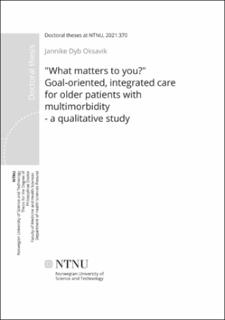| dc.contributor.advisor | Kirchhoff, Ralf | |
| dc.contributor.advisor | Sogstad, Maren Kristine Raknes | |
| dc.contributor.advisor | Solbjør, Marit | |
| dc.contributor.author | Oksavik, Jannike Dyb | |
| dc.date.accessioned | 2021-12-08T09:15:01Z | |
| dc.date.available | 2021-12-08T09:15:01Z | |
| dc.date.issued | 2021 | |
| dc.identifier.isbn | 978-82-326-6015-5 | |
| dc.identifier.issn | 2703-8084 | |
| dc.identifier.uri | https://hdl.handle.net/11250/2833287 | |
| dc.description.abstract | Even though patient participation has been upheld as an ideal in health policy for decades, older patients have participated only marginally in the formulation of their healthcare. Older patients with multimorbidity (that is, two or more chronic conditions) have complex needs for health and care services. The goals for the services that patients receive are often not unified, whether we are talking about alignment and integration between different service levels or between different health professionals and their respective patients. According to the literature on integrated care, a paradigm shift is now required for health services to become more centered on what matters to patients. Goal-oriented care is designed to elicit individual patients’ health-related goals and align care with these goals. In Norwegian primary health care, a goal-oriented intervention around care planning has been applied in integrated care for older patients with multimorbidity. Care planning is based on patients’ answer to the question “What matters to you?”. Little is known about the experiences and interactions that ensue when this intervention is carried out.
This thesis explores how patient participation emerges when the WMTY intervention is carried out. It explores integrated care as emergent social process. The aims are, firstly, to investigate normative integration, that is, how values and goals for the intervention are shared between different levels of the health services. This is operationalized through normative justifications for patient participation. Secondly, interpersonal integration is explored through the experiences related to patient participation and the interactions between health professionals and patients in care planning.
The three qualitative studies adopt a constructivist approach. They capture the perspectives of different actors and assess the implications of their interactions. The data was collected in four municipalities in Western Norway between September 2018 and December 2019. Prescriptive documents for the intervention included a governmental white paper, a guideline for patients with complex needs, and written checklists and intervention tools for health professionals. Direct observations of ten care-planning meetings were combined with individual interviews with patients after their meetings. Four focus-group discussions included a total of 24 health professionals. Data analyses include content analysis, grounded theory, and stepwise-deductive induction.
The results regarding normative integration between levels of health services indicate that the normative justifications for patient participation in the care planning intervention ranged from a principle of individualization at the macro-level to one of standardization at micro-level. This appeared through an examination of prevailing institutional logics, the number and range of which decreased moving down the levels (Paper 1). Health professionals took four different approaches to involving patients in the intervention: motivating for goals, vicariously setting goals, negotiating goals, and specifying goals. These four approaches are different ways in which health professionals shared responsibility for goal setting with patients (Paper 2). In the care-planning meetings, health professionals, relatives, and patients had different perceptions about what goals to set. Some patients experienced uncertainty in that the trajectory of their illness and their ability to participate in the rehabilitation process were unpredictable. The way uncertainty was handled in the meetings was associated with the level of patient participation and patients’ temporal focus in care planning (Paper 3).
This thesis extends our understanding of normative and interpersonal integration of goal oriented, integrated care. It illuminates how the social dynamics between actors and levels of health services emerge in goal setting for older patients with multimorbidity. Moreover, it provides insights about how and why the level of patient participation may vary in goal-oriented care for older patients with multimorbidity. | en_US |
| dc.language.iso | eng | en_US |
| dc.publisher | NTNU | en_US |
| dc.relation.ispartofseries | Doctoral theses at NTNU;2021:370 | |
| dc.relation.haspart | Paper I. Jannike Dyb Oksavik, Turid Aarseth, Marit Solbjør & Ralf Kirchhoff. What matters to you? Normative integration of an intervention to promote participation of older patients with multi-morbidity – a qualitative case study. BMC Health Services Research, 2021, 21 (117). DOI https://doi.org/10.1186/s12913-021-06106-y | en_US |
| dc.relation.haspart | Paper II. Jannike Dyb Oksavik1* , Ralf Kirchhoff1 , Maren Kristine Raknes Sogstad2 and Marit Solbjør. Sharing responsibility: municipal health professionals’ approaches to goal setting with older patients with multi-morbidity – a grounded theory study. BMC Health Services Research, 2020, 20 (141). DOI https://doi.org/10.1186/s12913-020-4983-3 | en_US |
| dc.relation.haspart | Paper III. Jannike Dyb Oksavik, Marit Solbjør, Ralf Kirchhoff & Maren Kristine Raknes Sogstad. Games of uncertainty: the participation of older patients with multimorbidity in care planning meetings – a qualitative study. BMC Geriatrics, 2021, 21, 242. DOI https://doi.org/10.1186/s12877-021-02184-z | en_US |
| dc.title | "What matters to you?" Goal-oriented, integrated care for older patients with multimorbidity - a qualitative study | en_US |
| dc.type | Doctoral thesis | en_US |
| dc.subject.nsi | VDP::Medisinske Fag: 700 | en_US |
